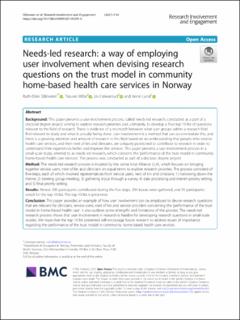Needs-led research: a way of employing user involvement when devising research questions on the trust model in community home-based health care services in Norway
Peer reviewed, Journal article
Published version
Permanent lenke
https://hdl.handle.net/11250/2978529Utgivelsesdato
2021-06-22Metadata
Vis full innførselOriginalversjon
Research Involvement and Engagement. 2021, 7 . https://doi.org/10.1186/s40900-021-00291-0Sammendrag
Background: This paper presents a user involvement process, called needs-led research, conducted as a part of a doctoral degree project aiming to explore research priorities and, ultimately, to develop a final top 10 list of questions relevant to the field of research. There is evidence of a mismatch between what user groups within a research field find relevant to study and what is actually being done. User involvement is a method that can accommodate this, and there is a growing attention and amount of research in this field based on an understanding that people who receive health care services, and their next of kin and clinicians, are uniquely positioned to contribute to research in order to understand their experiences better and improve the services. This paper presents a user involvement process in a small-scale study, referred to as needs-led research, which concerns the ‘performance of the trust model in community home-based health care services’. The process was conducted as part of a doctoral degree project.
Method: The needs-led research process is inspired by the James Lind Alliance (JLA), which focuses on bringing together service users, next of kin and clinicians on equal terms to explore research priorities. The process consisted of five-steps, each of which involved representatives from service users, next of kin and clinicians: 1) narrowing down the theme; 2) steering group meeting; 3) gathering input through a survey; 4) data processing and interim priority setting; and 5) final priority setting.
Results: Almost 200 participants contributed during the five steps, 294 inputs were gathered, and 35 participants voted for the top 10 list. The top 10 list is presented.
Conclusion: This paper provides an example of how user involvement can be employed to devise research questions that are relevant for clinicians, service users, next of kin and service providers concerning the ‘performance of the trust model in home-based health care’. It also outlines some strengths and limitations of the process. The needs-led research process shows that user involvement in research is feasible for developing research questions in small-scale studies. We hope that the top 10 list presented will encourage future research to address issues of importance regarding the performance of the trust model in community home-based health care services. User involvement is a topic that has received increasing attention in research aimed at ensuring relevant and needed knowledge. It can be practised in a variety of ways, and the literature claims that there is no gold standard for how it should be done. This paper presents a user involvement process conducted autumn 2019 to spring 2020, hereby referred to as needs-led research (NLR), inspired by the James Lind Alliance (JLA). The scope of the process is the ‘performance of the trust model in community home-based health care services’. The trust model is a new way of organising home-based health care services where small interdisciplinary teams work with the service users and their next of kin on tailoring the services based on the users’ answers to the question ‘What matters to you?’ Through a five-step process, in which representatives of service users, next of kin and clinicians participated in meetings and online surveys, the goal of the NLR process was to explore research priorities and, ultimately, to develop a final top 10 list of questions relevant to the field of research. This paper describes the NLR process and discusses its strengths and limitations. We found the process to be important when identifying relevant research questions concerning a topic on which little research has been conducted, and in which we as researchers have little experience. The final top 10 list is also presented.

